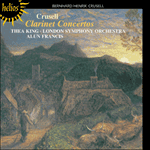
Welcome to Hyperion Records, a British classical label devoted to presenting high-quality recordings of music of all styles and from all periods from the twelfth century to the twenty-first.
Hyperion offers both CDs, and downloads in a number of formats. The site is also available in several languages.
Please use the dropdown buttons to set your preferred options, or use the checkbox to accept the defaults.

The slow movement (Andante pastorale) is in D flat major and has much of the romantic warmth traditionally associated with that key. Scored for clarinet and strings alone, it opens with a long melody for the clarinet accompanied by held chords and gentle pizzicato triplets on the cellos. The middle section explores darker minor-key regions before returning to a simple condensed repeat of the opening material. On this recording the cadenza just before the reprise, and the subsequent ornamentations, are by Alun Francis.
Despite the return to F minor, the final Rondo: Allegretto is high-spirited and gives ample opportunity for technical display, though Crusell wisely reserves his most brilliant writing for the coda.
from notes by Stephen Johnson © 1994
Le mouvement lent (Andante pastorale), en ré bémol majeur, revêt toute la chaleur romantique traditionnellement associée à cette tonalité. Orchestré pour clarinette et cordes seulement, il s’ouvre sur une longue mélodie à la clarinette accompagnée par des accords tenus et de délicats triolets pizzicato aux violoncelles. La section centrale explore des régions tonales mineures plus sombres avant de revenir à une simple répétition condensée du matériau du début. Sur cet enregistrement, la cadence précédant la reprise et les ornements qui s’ensuivent sont d’Alun Francis.
Malgré le retour de fa mineur, le rondo final (Allegretto) est un mouvement plein d’ardeur qui fournit au soliste de nombreuses occasions de démontrer sa virtuosité, bien que Crusell ait la sagesse de réserver ses plus brillants traits de plume pour la coda.
extrait des notes rédigées par Stephen Johnson © 1994
Français: Jean-Paul Metzger
Der langsame Satz (Andante pastorale) ist in Des-Dur geschrieben und enthält viel von der romantischen Wärme, die traditionsgemäß mit dieser Tonart verbunden wird. Das Werk, das nur für Klarinette und Streicher spartiert ist, eröffnet mit einer langen Melodie für die Klarinette, die von gehaltenen Akkorden und zarten Pizzicato-Triolen der Cellos begleitet wird. Der mittlere Teil erforscht die dunkleren Moll-Bereiche, bevor er zu einer einfachen, kondensierten Wiederholung des Einleitungsmaterials zurückkehrt. Auf dieser Aufnahme sind die Kadenz kurz vor der Reprise und die nachfolgenden Verzierungen von Alun Francis.
Trotz der Rückkehr zur f-Moll-Tonart ist das Rondo des Finales (Allegretto) temperamentvoll und gibt große Möglichkeiten für die Zurschaustellung von technischen Fähigkeiten, obwohl Crusell sein bestes Schreiben wohlweislich für die Koda aufbewahrt.
aus dem Begleittext von Stephen Johnson © 1994
Deutsch: Meckie Hellary
 Crusell: Clarinet Concertos Crusell: Clarinet Concertos‘The most rewarding clarinet concertos of the early 19th century. Strongly recommended’ (BBC Music Magazine) ‘Quite excellent, with wonderful ensemble from the London Symphony Orchestra and equally impressive solo efforts from King’ (Fanfare, USA)» More |

